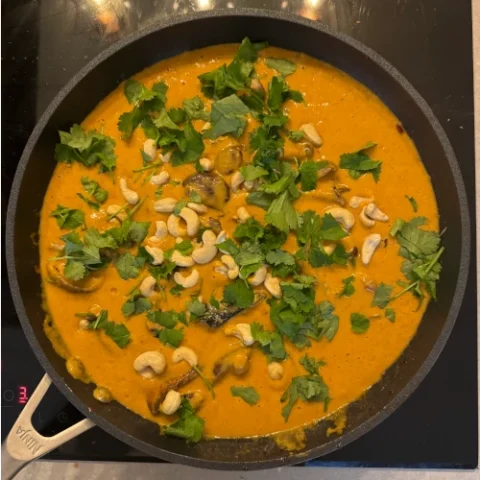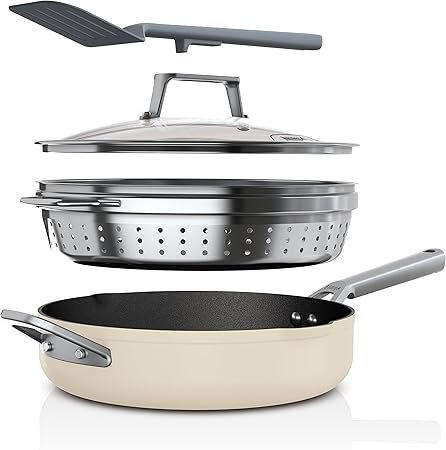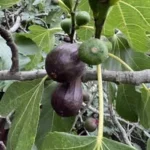
Mushroom Curry
Mushrooms have always felt a little magical to me. As a boy, I’d follow my dad into the forest, basket swinging at my side, searching for hidden treasures like cèpes and the mysterious trompettes de la mort. Those walks taught me to see mushrooms not just as food, but as a connection to nature, curiosity, and comfort.
That’s why they take centre stage in this autumnal curry. Inspired by flavours from different cuisines, I’ve layered it with caramel, smoke, sweetness, and spice – all designed to let the mushrooms shine. Mix as many varieties as you like; their quirky shapes and textures are what make this dish so special.
Simple, soulful, and a little nostalgic – this is a bowl to warm you through.
Ingredients
- Olive oil
- 400g mixed mushrooms, such as oyster, shiitake, button, lion’s mane, chestnut
- 1 mug of basmati rice (300g)
- 5cm piece of fresh ginger
- 1 onion
- 2 fresh red chillies
- 4 cloves of garlic
- 2 sticks of lemongrass
- 250g mixed-colour cherry tomatoes
- 8 lime leaves
- 1 tablespoon runny honey
- 2 tablespoons balsamic vinegar
- 1 tablespoon medium curry powder
- 2 tablespoons desiccated coconut
- 1 x 400g tin light coconut milk
- 2 tablespoons low-salt soy sauce
- 50g cashew nuts
- a few sprigs of fresh coriander
- 1 lime
Instructions
- Drizzle 1 tablespoon of olive oil into the base of a cold large non-stick frying pan, then season generously with sea salt and black pepper. Halve or quarter the mushrooms, leaving some whole so you get a mix of sizes, then arrange in the pan in an even layer.
- Place a large plate or a lid that’s smaller than the pan directly onto the mushrooms – the weight will help to release the mushrooms’ moisture, steaming them in the pan, while getting nice and crispy underneath. Place on a medium heat and cook for 15 minutes without stirring them, checking occasionally to make sure they don’t burn.
- Place the rice and 2 mugs (600ml) of boiling kettle water in a medium non-stick saucepan. Carefully peel the ginger with a knife and add the trimmings to the pan (this will subtly flavour the rice), season with salt, then cook with the lid on for 12 minutes, or until the rice is tender and all the water has been absorbed – don’t be tempted to stir it.
- Peel and cut the onion into chunky 1cm-thick rounds. Trim, deseed and halve the chillies lengthways, then peel the garlic cloves, leaving them whole. Trim and finely chop the lemongrass, then cut the peeled ginger into thick slices.
- Remove the mushrooms to a board, wipe the pan and return to a medium heat. Dry fry the onion rounds, chilli, garlic and ginger for 10 minutes, or until charred and fragrant, adding the whole tomatoes, lime leaves and lemongrass halfway.
- Check on your rice – once you can’t see any water on the bottom of the pan, turn the heat up to medium-high and cook with the lid off for 5 minutes, or until golden and crisp on the bottom (you’ll hear it crackling).
- Add the honey, balsamic and curry powder to the charred veg, and cook for another minute, or until glossy, stirring often. Transfer to a blender with the desiccated coconut, coconut milk (keep the empty tin for now) and soy sauce, blitz until smooth, then return to the frying pan with most of the cashew nuts, reserving a few for later, and season to perfection with salt.
- Roughly chop half the mushrooms, leaving the rest as they are, then stir into the sauce. Pick over the coriander leaves, sprinkle the reserved cashews on top and swirl over any remaining coconut milk from the tin. Tip out the rice onto a serving plate, finely grate over a little lime zest, then bring everything to the table, with lime wedges for squeezing over.
Recommended Products
As an Amazon Associate and member of other affiliate programs, I earn from qualifying purchases.
Nutrition Information:
Yield: 4 Serving Size: 1Amount Per Serving: Calories: 446Total Fat: 19gSaturated Fat: 9gTrans Fat: 0gUnsaturated Fat: 9gCholesterol: 6mgSodium: 390mgCarbohydrates: 64gFiber: 8gSugar: 16gProtein: 11g
The Comforting World of Mushroom Curry
There’s something undeniably magical about a good mushroom curry. The rich aroma of garlic, the earthy scent of mushrooms as they hit a hot pan, and the warming spices of curry all come together to create pure comfort. But this dish isn’t just about flavour—it’s also about nostalgia and connection to nature.
When I was younger, I loved going to the forest with my dad to look for mushrooms. We’d leave early, baskets in hand, and wander among mossy trees searching for cèpes (porcini) and trompettes de la mort (black trumpets). The thrill of spotting one hidden under leaves was akin to discovering treasure. Later, we’d cook them simply in a poêlée de champignons—just garlic, parsley, and olive oil. Nothing beats that.
The Best Mushrooms for a Curry
When it comes to a mushroom curry, texture and flavour matter. Here are some of the best mushrooms to use:
- Cremini or chestnut mushrooms: readily available and hold up beautifully in sauces.
- Portobello mushrooms: meaty and substantial, perfect for a hearty texture.
- Oyster mushrooms: delicate and slightly sweet, they absorb spices like a dream.
- Shiitake mushrooms: bring deep umami and a subtle smokiness.
- Porcini (cèpes): the king of flavour—earthy, nutty, and luxurious.
If you can get your hands on fresh wild mushrooms, they’ll elevate your curry to another level. Even a small handful of rehydrated dried porcini adds incredible depth to your sauce.
Mushrooms to Avoid in Cooking
Not all mushrooms are created equal. Some varieties can be too watery, bland, or even unsafe to eat raw. Avoid:
- Button mushrooms (when overcooked): they can release too much water and lose flavour.
- Field mushrooms (if too mature): the gills can make dishes overly dark and muddy in flavour.
- Foraged mushrooms you don’t recognise: unless you’re trained or guided by an expert, never pick or eat wild mushrooms you can’t identify—many are toxic.
If you’re interested in mushroom foraging safety, check out the Woodland Trust guide to mushroom foraging for UK-specific advice.
Countries with a Love for Foraging Mushrooms
Mushroom foraging is a cherished tradition in many countries:
- France: where my childhood memories began. Families often head to forests after rain in search of cèpes and girolles.
- Poland and the Czech Republic: mushroom picking is a beloved national pastime, with festivals celebrating the season.
- Finland: where jokamiehenoikeus (“everyman’s right”) allows everyone to freely forage in nature.
- Japan: home to prized mushrooms like matsutake, known for their aromatic intensity.
Across Europe and Asia, mushrooms aren’t just ingredients—they’re part of cultural heritage, symbolising connection to the land.
Nutrition and Benefits of Mushrooms
A good mushroom curry isn’t just satisfying—it’s deeply nourishing. Mushrooms are:
- Rich in B vitamins (especially riboflavin and niacin), supporting energy metabolism.
- High in antioxidants, helping protect cells from damage.
- Low in calories but high in fibre, keeping you full and satisfied.
- Packed with umami, enhancing plant-based dishes naturally.
They’re also one of the few plant sources of vitamin D, especially when sun-dried—making them an excellent addition to a vegan diet.
Bringing Forest Flavours to the Curry Bowl
This mushroom curry brings the soul of the forest into every spoonful — a comforting balance of earthiness, spice, and subtle sweetness. Using a mix of mushrooms such as oyster, shiitake, lion’s mane, and chestnut creates layers of texture and umami, while the aromatic base of ginger, garlic, onion, lemongrass, and chillies builds depth from the very start.
The addition of lime leaves infuses the sauce with a gentle citrus fragrance that pairs beautifully with the richness of coconut milk. A touch of honey and balsamic vinegar rounds out the curry with sweet-sour harmony, while curry powder and desiccated coconut bring warmth and body. The soy sauce ties everything together with a savoury note, balancing the creaminess perfectly.
As the curry simmers, the mushrooms soak up every bit of flavour, becoming tender yet satisfying. Scatter over cashew nuts for crunch and fresh coriander for a bright herbal lift, then finish with a squeeze of lime to wake everything up.
Serve your mushroom curry with steamed basmati rice, letting it soak up the fragrant sauce, or alongside naan for dipping. And if you want to echo those forest flavours even more, pair it with a garlicky poêlée de champignons—a simple sauté of mushrooms in olive oil, just like those you might find on a morning walk through the woods.
For mushroom lovers, don’t miss the Mycological Society’s resource on edible mushrooms to deepen your knowledge. And take a look at my other mushroom recipes.





[…] If you’re planning a full plant-based Indian feast, check out my Vegan Mushroom Curry […]